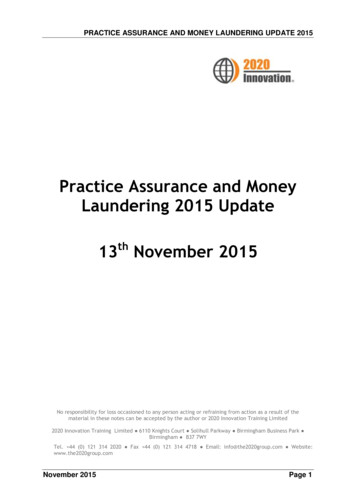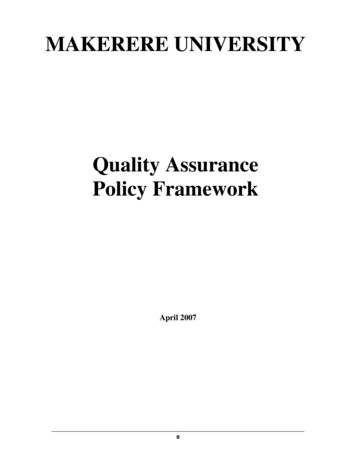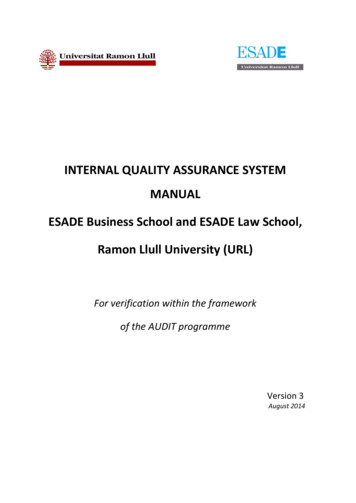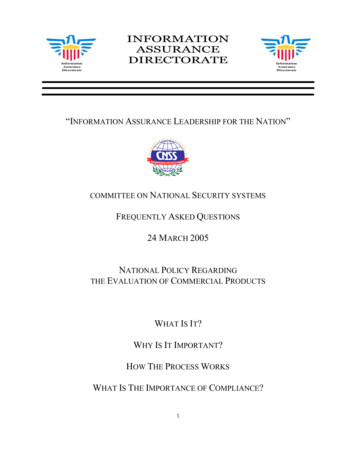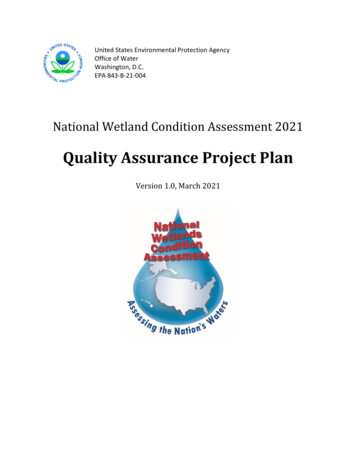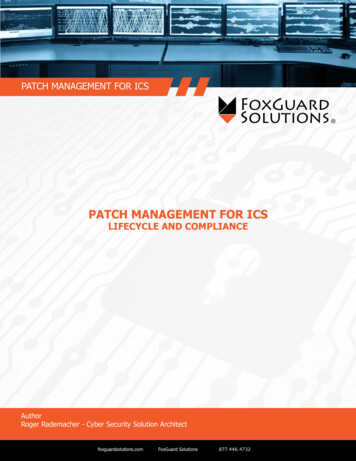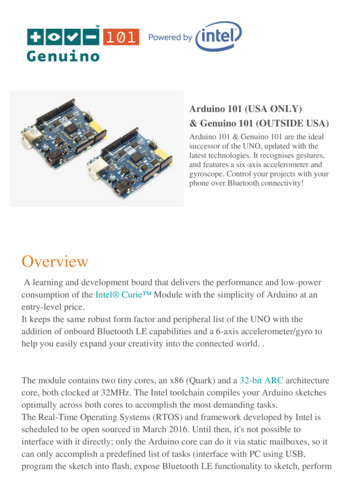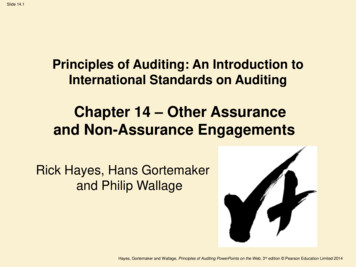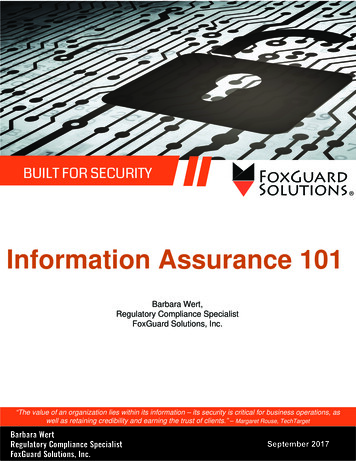
Transcription
BUILT FOR SECURITYInformation Assurance 101Barbara Wert,Regulatory Compliance SpecialistFoxGuard Solutions, Inc.“The value of an organization lies within its information – its security is critical for business operations, aswell as retaining credibility and earning the trust of clients.” – Margaret Rouse, TechTargetBarbara WertRegulatory Compliance SpecialistFoxGuard Solutions, Inc.September 2017
Executive SummaryWhat is Information Assurance, and why should we care?Headlines over the past 24 months have cited security breaches in Anthem, the Philippines’ Commissionon Elections (COMELEC), Wendy’s, LinkedIn, the Red Cross, Cisco, Yahoo, financial institutions aroundthe world, and even the U.S. Department of Justice. As well, statistics show that 43% of cyberattackstarget small businesses. Earlier this year, a high school server system in Illinois was infiltrated and theperpetrator attempted to extort the district for 37,000 in order to restore their access to theinformation on the servers. (1)Information Assurance programs provide a comprehensive approach to addressing the urgent need toprotect sensitive data and the systems that house the information for organizations of any size andindustry.This white paper will: Look at some key definitions in the scope of information assurance Discuss the basic factors of information assurance found in the CIA Triad Consider the role of risk management in an information assurance program Explore framework options
ContentsExecutive Summary. 2Introduction . 4Basic Definitions . 4Information Assurance (IA) . 4Information Assets . 5Information Security Management System (ISMS) . 5Cyber Security . 5Security Controls . 6The CIA Triad . 6Confidentiality . 6Integrity . 6Availability . 7Risk Management in an IA Program . 7Programs / Frameworks. 8ISO/IEC 27001:2013 . 8NIST’s Risk Management Framework (RMF) . 8The Cyber Security Framework . 9NERC CIP. 9Conclusion . 10FoxGuard Solutions, Inc. . 10References . 11
Introduction“The purpose of information security is to build a system that takes into account all possiblerisks to the security of information (IT or non-IT related), and implements comprehensivecontrols that reduce all kinds of unacceptable risks.” – Secure and Simple, A Small-Business Guide toImplementing ISO27001 on Your Own, by Dejan KosuticWelcome to the first of a series of white papers dealing with the ever-growing concern of InformationAssurance.As a manufacturer and integrator of IT/OT systems for diverse industries and end destinations, we atFoxGuard Solutions have found that one-size does not fit all when it comes to information assuranceprograms.When considering program options, two questions come to mind: What company needs and legislative requirements should be considered for your industry?What needs and legislative requirements of customers, and others further downstream on thesupply chain, including end users, should be considered?Basic DefinitionsInformation Assurance (IA)Simply put, Information Assurance (IA) is the practice of managing information-related risks. IA protectsinformation and information assets by addressing various areas of impact to the organization in theevent information security is breached or becomes inaccessible when needed.The three main areas of impact considered are: ConfidentialityIntegrityAvailabilityWe will look into these areas of impact (known as the “CIA Triad”) a bit further into the paper; but inshort, ensuring security in these areas results in information being available (1) to those, and only those,who should have access to it, (2) in its authentic form, and (3) at the time it’s needed.Some mistakenly think that IA is all about information technology equipment (ITE). ITE security is onlyone aspect of IA. Comprehensive information assurance considers multiple facets of an informationasset, including:
The physical environment surrounding the information assetOrganizational policies and operational processesEmployee awareness and training, and other applicable Human Resources programsDevelopment and support processesInformation transferSupplier relationshipsIncident managementChange managementMonitoring and reviews of information assets and security controlsInformation Assurance addresses both intentional and nonintentional dangers.Information AssetsAn information asset is an entity that can gather, store, transfer, or report information. Informationassets range from automated processing machines to file cabinets, to online storage tools, and even toan organization’s employees and contractors. Buildings, hard copy documents, electronic databases,DVDs and other media, reporting tools, and information technology infrastructure are among the longlist of information assets within an organization.Not all information assets are or remain “on site”. For example, a company or employee-owned vehicleis an information asset when used to carry laptops, files, reports, etc. from one location to another.Mobile phones provide access to all types of information, some of which can be confidential. Mailcarriers and courier services, consultants, and service providers must also be considered in acomprehensive IA program.Information Security Management System (ISMS)The purpose of an ISMS (also referred to as a “framework”) is to minimize risk and ensure businesscontinuity by implementing controls to limit the impact of a security breach. An ISMS is the compilationof policies and procedures, controls, and other guidance designed to address the elementsencompassing the security of information and information assets within an organization. An ISMS willaddress the facets of information assurance as outlined above, including organizational policies andprocedures pertaining to information security.Cyber SecurityCyber Security is the set of standards and processes implemented to safeguard computers, computernetworks, programs and information from attack, damage and unauthorized access. Cyber Security is anintegral part of a modern IA program. Cyberattacks can result in a loss of assets and credibility, crippledoperations, legal retribution, and even loss of life.(2) Keeping up with ever-increasing technology andnetworking has become a major challenge for organizations worldwide. Tactics such as spear phishing,skimming, and malware were the cause of several hundred cyber security breaches reported in 2016.(3)
Security ControlsSecurity controls are measures to detect, avoid and/or mitigate the effects of security breaches. Typesof controls vary according to the needs associated with an information asset, and include areas such as: Alarm systems and access control for physical locationsTechnical controls for computers, programs and networksPolicies and procedures to deter harmful actions and behaviorsThe CIA TriadThe CIA Triad is a model depicting the three chief goals of an IA program:ConfidentialityInformation that’s intended only for a restricted audience is called “confidential”.Often this information has the potential of compromising organizationaloperations, organizational assets, or individuals, should it be accessible tounauthorized parties.An unhappy employee sharing information with a competitor, inappropriate disposal of an informationasset containing sensitive data, unprotected storage of information, and unauthorized access to aninformation asset are just a few of the many ways that confidentiality can be breached.Control measures such as non-disclosure agreements, disposal procedures, and access restrictions canbe considered in response to confidentiality risks.IntegrityInformation integrity is the “assurance that the data being accessed has neither been tampered with,nor been altered or damaged through a system error, since the time of the last authorized access”. (4) Inother words, information integrity is the ability to ensure that accessed data is authentic to its originalcontent.Information can be altered maliciously or unintentionally, with threats ranging from user or applicationerror, to malicious code, theft or sabotage.Information backup, antivirus protection, information transfer procedures, and equipment maintenanceare measures that can be implemented to minimize integrity issues.
AvailabilityIn the context of an information asset, information availability refers to the ability of an authorized partyor system to access data at the appropriate time and in the appropriate format.Information and information assets can be rendered unavailable through data interception, equipmentfailure, misappropriation of resources, and adverse environmental conditions.Controls in the areas of asset handling, information transfer, and capacity management are ways tomitigate availability risks.Risk Management in an IA ProgramRisk Management, an integral part of a comprehensive information assurance program, is a systematicoverview of the threats and vulnerabilities associated with an information asset, and a subsequentdecision of which controls to put into place to reduce or eliminate the risk.The risk management process involves four basic steps:1. Identify the risk –o In what ways could this system, or the information in it, be exposed (Confidentiality),altered (Integrity), or made unavailable (Availability)?2. Analyze the risk –o What would the impact be (low, medium, high) to organizational operations and assets,individuals, and/or the environment if this system, or the information in it, iscompromised?o To what degree (if any) is the risk acceptable?o What controls are in place to protect this system and the information in it?o How likely is it that this system, or the information on it, will be compromised, given theexisting controls?3. Treat the risk –o What [further] controls will help mitigate the risk? What policies and/or processes needto be put into place?o What priority should be assigned to each of the control measures that need to be putinto place?4. Monitor the system and the controls put into place to mitigate the risk o Are the controls effectiveo Have any new risks to this system, or the information in it, been identified?Most information assets will have more than one identified risk; in fact, one system could easily have awhole list of threats and vulnerabilities associated with it!A Risk Assessment Table is a compilation of an organization’s information assets, the threats andvulnerabilities associated with each information asset, the impact and likelihood associated with eachthreat and vulnerability, controls already in place to avoid or mitigate risks, and controls that need to be
put into place to further ensure the confidentiality, integrity, and availability of the information and theinformation asset. From this table, a Risk Response can be formulated, giving a prioritized plan formitigating or accepting the identified risks.A risk management program is a living program. Updates should be made when: A new information asset is introduced to the organizationTechnology changes impact existing information assetsAn information asset is retiredExisting threats and vulnerabilities have been resolvedNew threats and/or vulnerabilities have been identifiedIn addition, periodic reviews afford the ability to assess the ongoing security of an organization’sinformation assets and the effectiveness of controls put into place to avoid or mitigate risk to thoseassets.Programs / FrameworksThe type of ISMS, or framework, an organization adopts can depend on factors such as industry type andthe size of the organization. Compliance requirements specific to the industry (such as HIPAA for thehealthcare industry) and the region (such as NERC for the North American power systems) must beconsidered to ensure the framework chosen meets applicable government and industry regulations.Most programs can be tailored to fit an organization’s specific needs.Below is an overview of several framework options.ISO/IEC 27001:2013ISO/IEC 27001:2013 (Information technology – Security techniques – Information security managementsystems – Requirements) is part of the ISO/IEC 27000 family, which pertains to ISMS. ISO/IEC27001:2013 provides the requirements for an ISMS, while other standards in the series provide securitycontrols, implementation guidance, risk management guidelines, ISMS auditing, and more. Advantagesof ISO 27001:2013 include certification and international recognition. ISO 27001 uses the Plan-DoCheck-Act (PDCA) cycle, which provides not only for initial implementation of policies and controls, butregular assessment and continuous improvement of the system as a whole.More information on ISO 27001: 2013 can be found at https://www.iso.org/standard/54534.html.NIST’s Risk Management Framework (RMF)The Computer Security Division of NIST (National Institute of Standards and Technology) developednumerous standards dealing with information security as part of the FISMA Implementation Project.FISMA (the Federal Information Security Management Act) is Title III of the E-Government Act (PublicLaw 107-347). In 2014 FISMA was amended by the Federal Information Security Modernization Act of
2014. NIST also developed a comprehensive Risk Management Framework (RMF) based on a set of NISTstandards, Federal Information Publications (FIPS), and other federal documents.The RMF process includes six steps that cover the life cycle of an information asset:1.2.3.4.5.6.Categorize the information assetSelect an initial set of baseline security controls for the information assetImplement the security controlsAssess the security controlsAuthorize system operationMonitor and assess on an ongoing basisGuidance for these steps is a work-in-process for NIST; currently FAQs, roles and responsibilities, andquick start guides are available for steps 1, 2, and 6.Although RMF was established as a mandatory program for federal agencies, it is also available for useby nonfederal agencies and other organizations.More information on RMF can be found at ml.The Cyber Security FrameworkAlso a NIST program, the Cyber Security Framework was developed pursuant to the 2013 ExecutiveOrder 13636, “Improving Critical Infrastructure Cyber Security”, and includes “a set of industrystandards and best practices to help organizations manage cybersecurity risks”. (3) The program consistsof three parts:1. The Framework Core –o A set of common cyber security activities and references2. The Framework Profile –o Guidance for tailoring the program to an individual organization3. The Framework Implementation Tiers –o Portrayal of an organization’s approach to managing cyber security riskAs with RMF, the Cyber Security Framework, although intended for use by organizations connected withU.S. critical infrastructure, is also available for use by other organizations.More information on the Cyber Security Framework can be found at https://www.nist.gov/cyberframework.NERC CIPThe North American Electric Reliability Corporation (NERC) Critical Infrastructure Protection (CIP) planwas developed to address the cyber security needs of the North American bulk electric system (BES).Current standards subject to enforcement include: CIP-002-5.1a:CIP-003-6:Cyber Security – BES Cyber System CategorizationCyber Security - Security Management Controls
05:CIP-009-06:CIP-010-2: CIP-011-2:CIP-014-2:Cyber Security - Personnel and TrainingCyber Security - Electronic Security PerimetersCyber Security - Physical Security of BES Cyber AssetsCyber Security - Systems Security ManagementCyber Security - Incident Reporting and Response PlanningCyber Security - Recovery Plans for BES Cyber SystemsCyber Security - Configuration Change Management and VulnerabilityAssessmentsCyber Security – Information ProtectionCyber Security – Physical SecurityFurther information on NERC CIP standards can be found .aspx.ConclusionIn this age of online communication and storage, cyber security breaches, and mobile resources, theprotection of an organization’s information and information assets is critical. As technology becomesmore sophisticated, so do tactics for unauthorized access and compromise to information assets. Tothis end, much effort has been put into designing and developing programs to help defend theconfidentiality, integrity, and availability of organizational information assets.While the focus of different frameworks may vary, many of the program fundamentals are the same.Key components include: implementation of policies and procedures designed to protect anorganization’s information and information assets; preparing a list of all information assets andassessing the risks associated with each asset; assigning and implementing controls to mitigate the risksidentified; continuous monitoring and assessment of the controls and the program to ensure its ongoingeffectiveness.When considering the options for an organization’s information assurance, regional and industryspecific regulations should be considered. Also consider that many programs can be tailored to meet anorganization’s specific needs, and components from multiple frameworks can be combined to create thebest program for your organization.FoxGuard Solutions, Inc.FoxGuard Solutions, Inc. is committed to providing secure computing solutions for our customers, aswell as protecting all customer data. As our Director of IT & Security Operations recently stated,“FoxGuard Solutions is committed to protecting our customers’ data from the prying eyes of would-bebad actors. When proprietary data must be exchanged between parties, we can provide securetransport via industry-standard SSL/TLS protocols, with no less than AES 128-bit encryption.”
FoxGuard has been BUILT FOR SECURITY for well over a decade, long before we began preparing for ISO27001:2013 registration and assessing our policies and processes for compliance to NIST SP 800-53controls and the Risk Management Framework (RMF).Our highly-skilled engineers can design systems to meet industry and project-specific standards,including those associated with the North American Electric Reliability Corporation’s CriticalInfrastructure Protection (NERC CIP) Standards, Nuclear Energy Institute’s Cyber Security Plan forNuclear Power Reactors (NEI 08-09), Security Technical Implementation Guides (STIGs) and SecurityReadiness Guides (SRGs), NIST SP 800-53 controls for Federal information and information systems, andNIST controls for protecting controlled unclassified information (CUI) in nonfederal information systemsand organizations (NIST SP 800-171).Next in our Series: NIST’s Risk Management Framework (RMF)References(1) ct-of-cyberattack(2) /(3) o-hacked(4) mation-integrity.html(5) /cyberframework/cybersecurity-framework-021214.pdf
Information Assurance 101 Barbara Wert, Regulatory Compliance Specialist FoxGuard Solutions, Inc. "The value of an organization lies within its information - its security is critical for business operations, as well as retaining credibility and earning the trust of clients." - Margaret Rouse, TechTarget Barbara Wert
